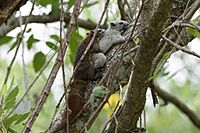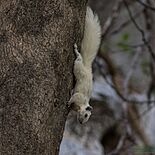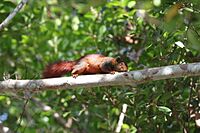Finlayson's squirrel facts for kids
Quick facts for kids Finlayson's squirrel |
|
|---|---|
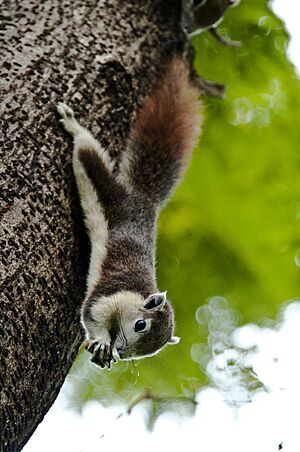 |
|
| C. f. bocourti in Bangkok, Thailand | |
| Conservation status | |
| Scientific classification | |
| Genus: |
Callosciurus
|
| Species: |
finlaysonii
|
| Subspecies | |
|
16 subspecies:
|
|
 |
|
The Finlayson's squirrel, also known as the variable squirrel (Callosciurus finlaysonii), is a type of rodent in the squirrel family. You can find these squirrels in countries like Cambodia, Laos, Myanmar, Thailand, and Vietnam. They live in many different wooded places, even in city gardens and parks, such as those in Bangkok. This squirrel was named after George Finlayson, a Scottish naturalist and traveler.
Finlayson's squirrels have many different types, called subspecies, which look very different from each other. One of these types, C. f. bocourti, has been brought to Singapore and parts of Italy. This probably happened because people kept them as pets. Some squirrels brought to Japan might also be Finlayson's squirrels. In the Greater Manila area of the Philippines, Finlayson's squirrels are considered an invasive species. This means they can cause harm to the local environment.
About Finlayson's Squirrel
Finlayson's squirrels are medium-sized. Their head and body are about 21 to 22 centimeters (8 to 9 inches) long. Their tail is a bit longer, measuring about 22 to 24 centimeters (9 to 9.5 inches).
What Does It Look Like?
There are currently 16 known subspecies of Finlayson's squirrel. Scientists sometimes recognize even more types. For example, some consider C. f. floweri a separate type, while others say it's the same as C. f. bocourti. The name C. f. boonsongi honors a Thai zoologist and conservationist named Boonsong Lekagul.
The fur color of these squirrels can be very different. Each subspecies often has its own unique color. For example:
- The C. f. finlaysonii type is mostly whitish.
- C. f. albivexilli, C. f. boonsongi, C. f. germaini, and C. f. nox are mostly blackish. Some might have a white tail-tip or white parts on their belly, face, and feet.
- C. f. annellatus is reddish-brown with a light band near the base of its tail.
- C. f. bocourti has a white belly, but its upper body can be white, gray, blackish, olive-brown, or reddish.
- C. f. cinnamomeus is mostly reddish with a dark stripe down its back.
- C. f. ferrugineus is reddish-brown.
- C. f. harmandi has brownish upper parts, orange-red underparts, and a light gray tail.
- C. f. menamicus is reddish or orangish, often with grayish legs and sides, and sometimes a white belly.
- C. f. sinistralis has speckled upper parts, reddish underparts, and a reddish tail with a pale band at the base.
Even within the same subspecies, individual squirrels can have slightly different colors. Scientists are still studying some populations that haven't been fully described yet. For example, some squirrels in central Laos are shiny black with a red tail and red on their shoulders and chest.
Scientists are also looking at the genes of Finlayson's squirrels. They think that what we call Finlayson's squirrel might actually be more than one species. Studies have shown that different groups of these squirrels are often separated by water, like large rivers or the sea. This research helps us understand how different squirrel types are related to each other.
How Do They Behave?
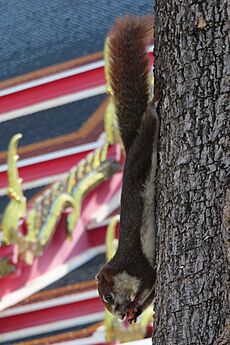
Like other "beautiful squirrels" in its group (the Callosciurus genus), Finlayson's squirrels usually live in the tops of trees. They spend most of their time in the tree canopy.
Eating Habits
These squirrels mainly eat fruit. Scientists believe they have a type of color vision that helps them tell the difference between ripe and unripe fruits. This is very helpful for finding the best food in the trees.



